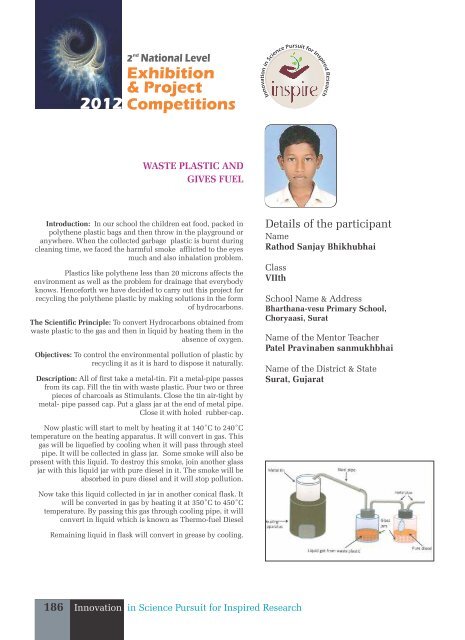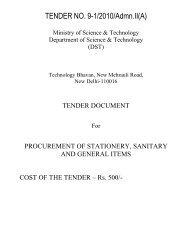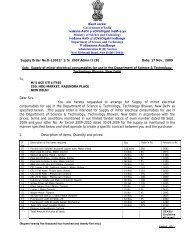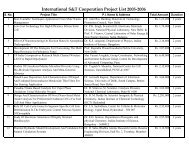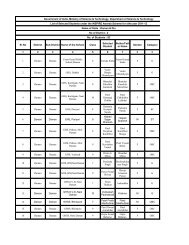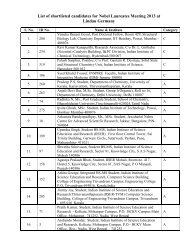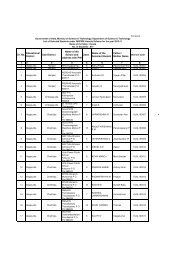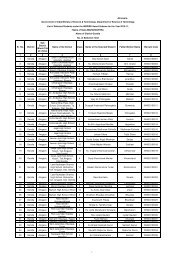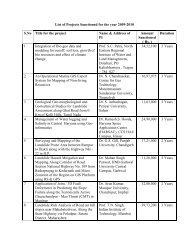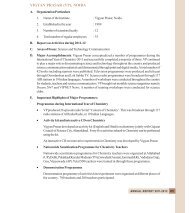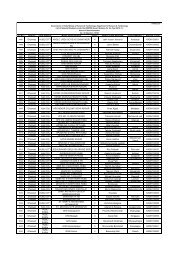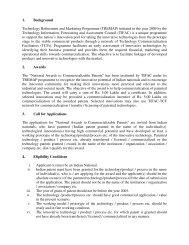- Page 1:
Compendium of Projects Exhibited Du
- Page 4:
e i c S n i n o i t a v o n n I n c
- Page 7 and 8:
e i c S n i n o i t a v o n n I n c
- Page 9:
e i c S n i n o i t n c e P rsu u i
- Page 12 and 13:
x Bihar Kumari Krity Bhushan 70 Bih
- Page 14 and 15:
xii Haryana Sukhdev 234 Haryana Man
- Page 16 and 17:
xiv Madhya Pradesh Surya Pratap Sin
- Page 18 and 19:
xvi Tamil Nadu S. Karthikeyan 567 T
- Page 21 and 22:
Details of the participant Name Tin
- Page 23 and 24:
Details of the participant Name Sat
- Page 25 and 26:
Details of the participant Name K.
- Page 27 and 28:
Details of the participant Name P.
- Page 29 and 30:
Details of the participant Name B.
- Page 31 and 32:
Details of the participant Name Pav
- Page 33 and 34:
Details of the participant Name N.
- Page 35 and 36:
Details of the participant Name D.
- Page 37 and 38:
Details of the participant Name CH.
- Page 39 and 40:
Details of the participant Name CH.
- Page 41 and 42:
Details of the participant Name A.
- Page 43 and 44:
Details of the participant Name K.J
- Page 45 and 46:
Details of the participant Name K.
- Page 47 and 48:
Details of the participant Name G.
- Page 49 and 50:
Details of the participant Name C.
- Page 51 and 52:
Details of the participant Name A.
- Page 53 and 54:
Details of the participant Name M.
- Page 55 and 56:
Details of the participant Name K.
- Page 57 and 58:
Details of the participant Name V.
- Page 59 and 60:
Details of the participant Name P.
- Page 61 and 62:
Details of the participant Name R.
- Page 63 and 64:
Details of the participant Name A.
- Page 65:
Details of the participant Name M.
- Page 69 and 70:
Details of the participant Name Abd
- Page 71 and 72:
su u it Details of the participant
- Page 73 and 74:
Details of the participant Name Abh
- Page 75 and 76:
Details of the participant Name Ank
- Page 77 and 78:
Details of the participant Name Amr
- Page 79 and 80:
Details of the participant Name Alo
- Page 81 and 82:
Details of the participant Name Avi
- Page 83 and 84:
Details of the participant Name Gud
- Page 85 and 86:
Details of the participant Name Kal
- Page 87 and 88:
Details of the participant Name Kum
- Page 89 and 90:
Details of the participant Name Kum
- Page 91 and 92:
Details of the participant Name Lal
- Page 93 and 94:
Details of the participant Name Mad
- Page 95 and 96:
Details of the participant Name MAN
- Page 97 and 98:
Details of the participant Name Md.
- Page 99 and 100:
Details of the participant Name NEE
- Page 101 and 102:
Details of the participant Name Niv
- Page 103 and 104:
Details of the participant Name Pam
- Page 105 and 106:
Details of the participant Name Poo
- Page 107 and 108:
Details of the participant Name Pra
- Page 109 and 110:
Details of the participant Name Rah
- Page 111 and 112:
Details of the participant Name Raj
- Page 113 and 114:
Details of the participant Name Rak
- Page 115 and 116:
Details of the participant Name Rau
- Page 117 and 118:
Details of the participant Name Ree
- Page 119 and 120:
Details of the participant Name Ric
- Page 121 and 122:
Details of the participant Name Ros
- Page 123 and 124:
Details of the participant Name Saj
- Page 125 and 126:
Details of the participant Name San
- Page 127 and 128:
Details of the participant Name San
- Page 129 and 130:
Details of the participant Name Shu
- Page 131 and 132:
Details of the participant Name Son
- Page 133 and 134:
Details of the participant Name Sur
- Page 135 and 136:
Details of the participant Name Vin
- Page 137:
Details of the participant e i c S
- Page 141 and 142:
Details of the participant Name Paw
- Page 143 and 144:
Details of the participant Name Sum
- Page 145 and 146:
Details of the participant Name Moh
- Page 147 and 148:
Details of the participant Name Vir
- Page 149 and 150:
Details of the participant Name Ku.
- Page 151 and 152:
Details of the participant Name Har
- Page 153 and 154: Details of the participant Name Gov
- Page 155 and 156: Details of the participant Name Ama
- Page 157 and 158: Details of the participant Name Aka
- Page 159 and 160: Details of the participant Name Kam
- Page 161 and 162: Details of the participant Name Lal
- Page 163 and 164: Details of the participant Name Yog
- Page 165 and 166: Details of the participant Name Adi
- Page 167 and 168: Details of the participant Name Rav
- Page 169 and 170: Details of the participant Name Sou
- Page 171 and 172: Details of the participant Name Rah
- Page 173 and 174: Details of the participant Name Suk
- Page 175 and 176: Details of the participant Name Rak
- Page 177 and 178: Details of the participant Name Man
- Page 179 and 180: Details of the participant Name Pan
- Page 181 and 182: Details of the participant Name Upd
- Page 183 and 184: Details of the participant Name Aas
- Page 185 and 186: Details of the participant Name Ku.
- Page 187 and 188: Details of the participant Name Sha
- Page 189 and 190: Details of the participant Name Pra
- Page 191: Details of the participant Name Dig
- Page 195 and 196: Details of the participant Name Cri
- Page 197 and 198: e i c S n i n o i t a v o n n I n c
- Page 199: e i c S n i n o i t a v o n n I n c
- Page 203: Details of the participant Name Pat
- Page 207 and 208: Details of the participant Name Rav
- Page 209 and 210: Details of the participant Name Pri
- Page 211 and 212: Details of the participant Name Him
- Page 213 and 214: Details of the participant Name Pat
- Page 215 and 216: Details of the participant Name Cha
- Page 217 and 218: Details of the participant Name Pra
- Page 219 and 220: Details of the participant Name Bam
- Page 221 and 222: Details of the participant Name Bha
- Page 223 and 224: Details of the participant Name GOH
- Page 225 and 226: Details of the participant Name Sut
- Page 227 and 228: Details of the participant Name Aah
- Page 229 and 230: Details of the participant Name Ran
- Page 231 and 232: Details of the participant Name Gea
- Page 233 and 234: Details of the participant Name Khu
- Page 235: Details of the participant Name Har
- Page 239 and 240: Details of the participant Name MUK
- Page 241 and 242: Details of the participant Name Man
- Page 243 and 244: Details of the participant Name Nis
- Page 245 and 246: Details of the participant Name ANK
- Page 247 and 248: Details of the participant Name DEE
- Page 249 and 250: Details of the participant Name Neh
- Page 251 and 252: Details of the participant Name Moh
- Page 253 and 254: Details of the participant Name MAN
- Page 255 and 256:
Details of the participant Name She
- Page 257 and 258:
Details of the participant Name ANK
- Page 259:
e i c S n i n o i t a v o n n I n c
- Page 262 and 263:
FIRE ALARM Fire Alarm is a device w
- Page 264 and 265:
2012 nd 2 National Level Exhibition
- Page 266 and 267:
2012 nd 2 National Level Exhibition
- Page 268 and 269:
2012 nd 2 National Level Exhibition
- Page 270 and 271:
2012 nd 2 National Level Exhibition
- Page 272 and 273:
2012 nd 2 National Level Exhibition
- Page 274 and 275:
2012 nd 2 National Level Exhibition
- Page 276 and 277:
2012 nd 2 National Level Exhibition
- Page 278 and 279:
2012 nd 2 National Level Exhibition
- Page 280 and 281:
2012 nd 2 National Level Exhibition
- Page 283 and 284:
Details of the participant Name Shi
- Page 285 and 286:
Details of the participant Name Suh
- Page 287 and 288:
Details of the participant Name Aay
- Page 289 and 290:
Details of the participant Name Tar
- Page 291 and 292:
Details of the participant Name Yog
- Page 293 and 294:
Details of the participant Name Rid
- Page 295 and 296:
Details of the participant Name Aja
- Page 297 and 298:
Details of the participant Name Sha
- Page 299:
e i c S n i n o i t a v o n n I n c
- Page 302 and 303:
DISASTER MANAGEMENT A project for m
- Page 304 and 305:
ACIDIC SOIL AND BIOCHAR ITS RESCUE
- Page 306 and 307:
An original idea of inter conversio
- Page 308 and 309:
SMALL WATER PUMPING MACHINE IN THE
- Page 310 and 311:
An idea of inter conversion of ener
- Page 312 and 313:
In the present days electricity is
- Page 314 and 315:
MAGNETIC LEVITATION WIND TURBINE Th
- Page 316 and 317:
ADVERSITY TO BLESSING- A THOUGHT TO
- Page 319 and 320:
Details of the participant Name Aab
- Page 321 and 322:
Details of the participant Name Har
- Page 323 and 324:
Details of the participant Name Hem
- Page 325 and 326:
Details of the participant Name Man
- Page 327 and 328:
Details of the participant Name Nan
- Page 329 and 330:
Details of the participant Name Bhu
- Page 331 and 332:
Details of the participant Name Har
- Page 333 and 334:
Details of the participant Name M.
- Page 335 and 336:
Details of the participant Name Kru
- Page 337 and 338:
Details of the participant Name Man
- Page 339 and 340:
Details of the participant Name Aka
- Page 341 and 342:
Details of the participant Name Vin
- Page 343 and 344:
Details of the participant Name Pra
- Page 345 and 346:
Details of the participant Name Sac
- Page 347 and 348:
Details of the participant Name K.
- Page 349 and 350:
Details of the participant Name Pav
- Page 351 and 352:
Details of the participant Name Neh
- Page 353 and 354:
Details of the participant Name She
- Page 355 and 356:
Details of the participant Name Pra
- Page 357 and 358:
Details of the participant Name Bha
- Page 359 and 360:
Details of the participant Name Cha
- Page 361 and 362:
Details of the participant Name Moh
- Page 363 and 364:
Details of the participant Name K N
- Page 365 and 366:
Details of the participant Name Swa
- Page 367 and 368:
Details of the participant Name Shi
- Page 369 and 370:
Details of the participant Name Gan
- Page 371 and 372:
Details of the participant Name Amb
- Page 373 and 374:
Details of the participant Name Kav
- Page 375 and 376:
Details of the participant Name Sum
- Page 377 and 378:
Details of the participant Name Shr
- Page 379 and 380:
Details of the participant Name N.S
- Page 381 and 382:
Details of the participant Name Dhr
- Page 383:
e i c S n i n o i t a v o n n I n c
- Page 386 and 387:
RICE DISTRIBUTION MACHINE Rice Dist
- Page 388 and 389:
LOW COST HIGHWAY WIND GENERATOR Imp
- Page 390 and 391:
IR MUSIC TRANSMITTER AND RECEIVER I
- Page 393 and 394:
Details of the participant Name Rad
- Page 395 and 396:
Details of the participant Name Roh
- Page 397 and 398:
Details of the participant Name Puj
- Page 399 and 400:
Details of the participant Name Arv
- Page 401 and 402:
Details of the participant Name Poo
- Page 403 and 404:
Details of the participant Name Shr
- Page 405 and 406:
Details of the participant Name Pan
- Page 407 and 408:
Details of the participant Name Art
- Page 409 and 410:
Details of the participant Name Ume
- Page 411 and 412:
Details of the participant Name Mad
- Page 413 and 414:
Details of the participant Name Mit
- Page 415 and 416:
Details of the participant Name Nik
- Page 417 and 418:
Details of the participant Name Poo
- Page 419 and 420:
Details of the participant Name Tus
- Page 421 and 422:
Details of the participant Name Yas
- Page 423 and 424:
Details of the participant Name Dil
- Page 425 and 426:
Details of the participant Name Nit
- Page 427 and 428:
Details of the participant Name Mah
- Page 429 and 430:
Details of the participant Name Poo
- Page 431 and 432:
Details of the participant Name Sha
- Page 433 and 434:
Details of the participant Name Paw
- Page 435 and 436:
Details of the participant Name Tan
- Page 437 and 438:
Details of the participant Name Ayu
- Page 439 and 440:
Details of the participant Name Ank
- Page 441 and 442:
Details of the participant Name Chi
- Page 443 and 444:
Details of the participant Name Rav
- Page 445 and 446:
Details of the participant Name Neh
- Page 447 and 448:
Details of the participant Name Rah
- Page 449 and 450:
Details of the participant Name Pra
- Page 451 and 452:
Details of the participant Name Jeb
- Page 453:
e i c S n i n o i t a v o n n I n c
- Page 456 and 457:
AUTOMATIC SWITCHING OF MOTOR (SAVE
- Page 458 and 459:
COMPOSITE LAMP Apparatus: 1) Parafi
- Page 460 and 461:
URINE WASTE RECYCLING PLANT Urine i
- Page 462 and 463:
Process of Purification: 1. First c
- Page 464 and 465:
2012 nd 2 National Level Exhibition
- Page 466 and 467:
2012 nd 2 National Level Exhibition
- Page 468 and 469:
2012 nd 2 National Level Exhibition
- Page 470 and 471:
2012 nd 2 National Level Exhibition
- Page 472 and 473:
2012 nd 2 National Level Exhibition
- Page 474 and 475:
2012 nd 2 National Level Exhibition
- Page 476 and 477:
2012 nd 2 National Level Exhibition
- Page 478 and 479:
2012 nd 2 National Level Exhibition
- Page 480 and 481:
2012 nd 2 National Level Exhibition
- Page 482 and 483:
2012 nd 2 National Level Exhibition
- Page 484 and 485:
2012 nd 2 National Level Exhibition
- Page 486 and 487:
2012 nd 2 National Level Exhibition
- Page 489:
e i c S n i n o i t a v o n n I n c
- Page 492 and 493:
HYDROGEN PRODUCTION AND ITS APPLICA
- Page 494 and 495:
“ONTHOKPA LOO” (NEW FISH TRAPPI
- Page 497:
e i c S n i n o i t a v o n n I n c
- Page 500 and 501:
RAIN WATER HARVESTING The common co
- Page 502 and 503:
2012 nd 2 National Level Exhibition
- Page 505:
e i c S n i n o i t a v o n n I n c
- Page 508 and 509:
GREYWATER RECYCLE SYSTEM Greywater
- Page 510 and 511:
2012 nd 2 National Level Exhibition
- Page 513:
e i c S n i n o i t a v o n n I n c
- Page 516 and 517:
ELECTRO MAGNETIC CRANE This model i
- Page 518 and 519:
2012 nd 2 National Level Exhibition
- Page 520 and 521:
2012 nd 2 National Level Exhibition
- Page 522 and 523:
2012 nd 2 National Level Exhibition
- Page 524 and 525:
2012 nd 2 National Level Exhibition
- Page 526 and 527:
2012 nd 2 National Level Exhibition
- Page 528 and 529:
2012 nd 2 National Level Exhibition
- Page 530 and 531:
2012 nd 2 National Level Exhibition
- Page 532 and 533:
2012 nd 2 National Level Exhibition
- Page 535:
e i c S n i n o i t a v o n n I n c
- Page 538 and 539:
The main aim in designing this is t
- Page 540 and 541:
Preparation of Natural fertilizer :
- Page 542 and 543:
CURRENT THEFT The indicater is most
- Page 544 and 545:
USABLE RESOURCES FOR CONSERVATION O
- Page 546 and 547:
WASTE WATER TREATMENT AND MANAGEMEN
- Page 548 and 549:
PHOTOGRAPH OF THE MODEL MODIFIED WI
- Page 550 and 551:
WATER - POWERED BIKE The name of th
- Page 552 and 553:
MULTIPLE ENERGY POWER PRODUCING I h
- Page 554 and 555:
Keep This Way:- 1. If we use rain w
- Page 556 and 557:
MODERN AGRICULTURE The new systems
- Page 558 and 559:
RECYCLING THE WASTE MATERIAL TO AVO
- Page 560 and 561:
CURRENT FROM SEPTIC TANK In our met
- Page 562 and 563:
GLOBAL WARMING Imagine a world wher
- Page 564 and 565:
GEOTHERMAL POWER PLANT Introduction
- Page 566 and 567:
Aim :- Best from worst Dirty Water
- Page 568 and 569:
SOLAR WATER HEATER Aim : To heat th
- Page 570 and 571:
BIO-DIESEL PREPARATION FROM WASTE A
- Page 572 and 573:
EFFLUENT WATER TREATMENT Aim :- To
- Page 574 and 575:
PREVENTION OF TRAIN Aim Most of the
- Page 576 and 577:
AUTOMATIC SOUND MAKER Name of my pr
- Page 578 and 579:
HOME AUTOMATION At present, all the
- Page 580 and 581:
CONSERVATION OF BIO-DIVERSITY CONSE
- Page 582 and 583:
INDIA 2025 (HYDROPONIC HOUSE) Hydro
- Page 584 and 585:
POWER GENERATION FROM THE AGRICULTU
- Page 586 and 587:
ENERGY IN NATURE Energy can be deri
- Page 588 and 589:
To safeguard trains and men's lives
- Page 590 and 591:
REVERSIBLE ENERGY FROM WASTE Electr
- Page 592 and 593:
GREEN HOME According to IEA, xistin
- Page 594 and 595:
FIGHT GLOBAL WARMING WITH GENETICAL
- Page 596 and 597:
GEO THERMAL POWER POINT Heat from t
- Page 598 and 599:
TO PROTECT ENVIRONMENT From our hou
- Page 600 and 601:
AUTOMATIC STREET LIGHT AND CONVERSI
- Page 602 and 603:
This experiment based on friction f
- Page 604 and 605:
CARBON CAPTURE AND STORAGE The prev
- Page 606 and 607:
SOLAR DRIER The slope and solar pan
- Page 608 and 609:
Situation :- When a child fells int
- Page 610 and 611:
COMPRESSIVE MOTOR (WITHOUT ELECTRIC
- Page 612 and 613:
WOODEN GASIFIRE BURNER The name of
- Page 614 and 615:
AUTOMATIC FIRE EXTINGUISHER Fire is
- Page 616 and 617:
GENERATING POWER FROM AGRICULTURAL
- Page 618 and 619:
UNMANNED RAILWAY GATE Topic: Avoid
- Page 620 and 621:
AUTOMATIC DIM AND DIPPER LIGHT CONT
- Page 622 and 623:
CORAL LODGE BIOGAS Human excreta ba
- Page 624 and 625:
POLLUTION (THREE TYPES OF POLLUTION
- Page 626 and 627:
ZERO - CARBON HOUSE The zero carbon
- Page 628 and 629:
STREET LIGHT AUTOMATIC ON/OFF This
- Page 630 and 631:
—Three process are taking part in
- Page 632 and 633:
(i) MAKING MOULDING MODELS USING WA
- Page 634 and 635:
Electricity produce from Home Wasta
- Page 636 and 637:
SCHOOL GETTING UNINTERRUPTED SUPPLY
- Page 638 and 639:
FIRE EXTINGUISHER This fire extingu
- Page 641 and 642:
Details of the participant e i c S
- Page 643 and 644:
Details of the participant Name Rah
- Page 645:
Details of the participant Name Yas
- Page 649 and 650:
Details of the participant Name Pri
- Page 651 and 652:
Details of the participant Name Suj
- Page 653 and 654:
Details of the participant Name Suk
- Page 655 and 656:
Details of the participant Name Khe
- Page 657 and 658:
Details of the participant Name See
- Page 660:
Government of India Ministry of Sci


